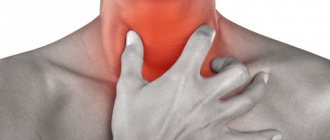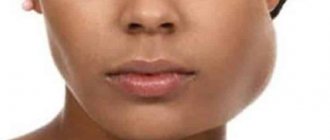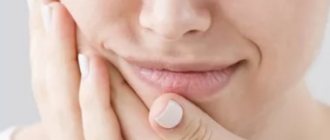The occurrence of this complex of symptoms must be treated carefully.
Simultaneous pain in the jaw and ear causes a lot of inconvenience and anxiety. Moreover, it is quite difficult for a person to determine the cause of pain on his own.
The primary source of anxiety may be dental problems or ear problems. To help a person with such a complex complaint, when the ear and jaw hurt on one side, you need to understand the possible sources of pain.
If the cause of pain is a problem with bone tissue
Pain emanating from the bone and joint structures of the jaw can spread to the ear area.
Bone fractures
During accidents and other types of incidents, head injuries can occur, which cause fractures of the facial bones of the skull and jaw.
The most common injury accompanied by jaw pain is a jaw fracture. It occurs due to the great force of the blow applied to the face, which is why pain is felt in the jaw in the ear area.
This type of fracture can be identified by symptoms:
- hematoma at the fracture site;
- pain when trying to open your mouth and chewing;
- swelling of the tissues; with a severe fracture, severe swelling is possible, spreading to the face;
- With complex fractures, bones are displaced and the soft tissues of the oral cavity are damaged.
Important: after a strong blow, dislocation of the jaw joint is also possible, in which case pain will be observed during chewing movements.
Osteomyelitis of the jawbone
This disease is characterized by damage to the bone tissue of the jaw. It occurs under the influence of pathogenic microorganisms that penetrate the bone through the root canals of diseased teeth. This disease is considered a consequence of neglected dental problems and not timely treatment of pulpitis.
In addition to pain in the jaw and ear, symptoms include:
- increased body temperature, feeling of chills;
- swelling of facial tissues and the appearance of its asymmetry;
- lymph nodes increase in size.
This disease is very dangerous and requires qualified treatment.
Important: prolonged pain of a nagging and aching nature requires mandatory consultation with a doctor, because these symptoms are typical in the presence of neoplasms.
Ear hurts: what to do?
When dealing with ear pain, the main thing is not to self-medicate. When trying to determine the cause of ear pain on your own, it is easy to make mistakes. It is not always clear even where the source of pain is located - in the auditory canal or the tympanic chamber. Therefore, starting treatment without consulting a doctor is dangerous - you may be treating the wrong thing, and the disease, left to itself, in the meantime can take a more severe form.
If the ear pain does not go away within two days or it particularly bothers you, you should consult an ENT specialist. Experienced ENT doctors at Family Doctor will help determine the cause of pain and prescribe an effective course of treatment for both adults and children.
If the cause of pain is joint problems
Disturbances in the functioning of the temporomandibular joint can cause pain spreading from the jaw to the ear. Patients describe their sensations as if their ear hurts when they move their jaw. Inflammatory processes occurring in the joint limit its normal motor ability.
Diseases such as arthritis and arthrosis affect joints; these degenerative phenomena destroy joint tissue, causing the patient a lot of inconvenience. The pain is more often described as aching, pressing. There is a feeling of a joint clicking when moving, a feeling of clinging. After sleep, stiffness in movements is felt. When pressing on the joint area, pain occurs.
Inflammation can occur due to hypothermia of the joint area; it is not uncommon for a person to be blown away. Along with the joint, other organs, such as the ear and nerves, can also become hypothermic. Hypothermia can cause problem teeth to ache.
Photos and videos in this article will demonstrate the nature of the origin of pain during degenerative processes in the joint.
If the cause of pain is neuralgia
Simultaneous pain in the ear and jaw occurs due to neuralgia of the cranial nerves passing in this area.
The pain has a different character:
- burning long-term pain;
- short-term shooting pain;
- pain may be of a jerking nature.
In the area of the ear and jaw joint there is a place where the fibers of the trigeminal nerve exit to the surface of the skull. This nerve is characterized by increased pain in the late evening and at night.
Neuralgia pain can be very painful
Also another situation why the jaw and ear hurt is neuralgia of the laryngeal nerve. Then the source of pain will be felt in the larynx, from which the pain will spread to the jaw and ear. Pain is felt on the left or right side, and bilateral pain can also spread. It occurs when you move your head, blow your nose, or cough.
Cases of neuralgia of the glossopharyngeal nerve are very rare. Attacks of pain in this case radiate to the temporomandibular joint, pharynx, eye and ear. A common symptom is the occurrence of a causeless dry cough.
Important: with all types of neuralgia, pain intensifies when eating very cold or very hot food.
Ringing and noise in the ears are a common manifestation of temporomandibular joint dysfunction.
A fairly common manifestation of jaw joint dysfunction is ringing, noise, maybe even whistling, rustling in the ears, as well as congestion and hearing loss. These phenomena can be either independent or occur when moving the head, shoulders, moving the tongue or even the eyes.
There are two forms of tinnitus: central origin, which is predominantly symptomatic, and sounds associated with visible vibration of the eardrum, which can be seen during examination at an appointment with an ENT doctor.
A connection was experimentally established between dysfunction of the jaw joints, when the articular heads occupy a posterior position in their articular fossae, causing increased tone of the masticatory muscles. Anatomically, the muscles of the middle ear, responsible for the production of sounds, have a common nature of innervation with the muscles of the palate and the muscles of the auditory tubes.
The neuromuscular approach to the treatment of such patients has experimentally shown that when 136 muscles are relaxed, including the muscles of the middle ear and palate using electrical myostimulation, this entire muscle group is affected. By influencing the trigeminal, accessory and vagus nerves through the skin with a small amplitude of current, the eardrums and muscles that lift the soft palate relax.
The Dental Spa clinic successfully uses the neuromuscular approach to treat patients with noise and ringing in the ears. Using the Myotronics K7 diagnostic computer system (electromyography, computed gnathography, electrosonography) and electromyostimulation of muscles innervated by three different groups of nerves for 60-90 minutes with the Myotronics J5 myomonitor, a biometric study is performed before and after muscle relaxation.
A mandibular apparatus (orthotic or Pull Forward) is manufactured, which, when worn continuously, helps restore the tone of the ear muscles, which results in a decrease or complete disappearance of noise and ringing, as well as debt in the ears.
Also, when treating such patients, it is taken into account that when the upper jaw is narrowed, the muscle that lifts the soft palate is also in increased tone. And since it connects to the muscle that strains the eardrum, this can also affect the occurrence of noise, whistling and ringing in the ears. Therefore, the Dental Spa clinic often performs expansion of the upper jaw using special invisible orthodontic devices (ALF light wire technique, FAGGA, RAGGA devices). As a result of this treatment, the upper jaw expands, which helps normalize the tone of the muscle that lifts the soft palate and reduces or, as often happens, completely eliminates noise and ringing in the ears.
Sign up for a consultation with a leading expert in the field of neuromuscular dentistry, Elena Leonidovna Vedernikova, and take the first step towards a healthy and happy life right now! Call 229-78-83
Literature:
1. Gelb H, Geld M, Wagner M, The relationship of Tinnitus to Craniocervical Mandibular Disorders. J Cranio mandi - bular Pract 2010, Vol 15, No. 2
2. Rood SR, Doyle WJ Morphology of the Tensor levi palatini, Tensor tympani and dilatator tubae muscules. Ann Otol Rinol Laryngol 1978;87:202-10
3. Rowiki T, Xakraewska J, A study of the discomalleolar ligament in the adult human. Folia Morphol 2006, Vol65, 2, pp. 121-125
If the cause of pain is dental problems
Important: through teeth affected by caries, pathogenic microorganisms can penetrate through the roots into neighboring tissues and cause severe inflammatory processes and illnesses.
Growing wisdom teeth can cause many problems
Soreness in the ear or jaw is often the result of dental problems, such as:
- Untreated caries may not be visible externally. For example, hidden caries is not noticeable to the patient; it will only make itself felt by painful sensations, such as pain in the ear, pain in the jaw.
- Pulpitis can be so painful that it is sometimes difficult to recognize the source of the pain. Pulpitis is characterized by prolonged pain at night. Also pain that renews from cold and hot foods, which does not go away for a long time.
- Wisdom teeth that are incorrectly positioned in the gums will put pressure on surrounding teeth or injure soft tissues when they start to grow. Pain provoked by pressure can radiate to the angle of the jaw and ear, so that a person may not immediately understand the source of the pain.
- Even if the wisdom tooth is positioned correctly, when it erupts, pain is possible, which can be felt in neighboring tissues. Sometimes the eruption of a wisdom tooth is accompanied by an inflammatory process of the gum hood above the tooth itself.
- Periodontal abscess is a serious exacerbation of dental problems. The pain from it spreads to the jaw, eyes and ears. The sensations are pulsating in nature, the pulsation comes from the root of the tooth. With this problem, there may be a decrease in the sensitivity of the receptors in the lower lip, as well as a weakening of the masticatory muscles.
- If a person has recently had braces or dentures installed, during the adaptation period there will be discomfort, even pain. This phenomenon should go away, if this does not happen, then you should consult your doctor; it may be necessary to adjust the installed structure.
- Advanced inflammation of the gums or periodontitis can cause anxiety in the form of pain radiating to the jaw joint and ear.
Important: one of the complications of untimely treatment of caries and pulp inflammation is the formation of a cyst, in which a person will experience pain that resonates in the surrounding tissues.
Why does toothache radiate to the ear?
Pain in the ear is observed with disease of the lower molars, and anterior to the tragus - with the upper molars. More often it appears as a result of deep caries and its complications. Diagnosed with the eruption of wisdom teeth, alveolitis, amphodontosis.
Advanced form of caries of extreme teeth
Caring for molars, or molars, is more difficult. In this regard, carious processes often start. The development of caries leads to the fact that not only the tooth, but also the ear begins to hurt. Ear pain worsens while eating, closer to evening.
Pulpitis
Pathology appears as caries progresses. An inflamed pulp causes severe spontaneous pain. Not only the tooth can cause concern, but also the ear close to it, the back of the head and the cheek. Irradiation is observed along the corresponding branch of the trigeminal nerve. Painful sensations are both short-term and long-term.
Alveolitis
Develops as a result of infection, extraction trauma. It is characterized by an inflammatory process of the walls of the socket of the extracted tooth. Pain syndrome appears 1-3 days after removal, accompanied by an increase in temperature. At first the pain is aching and intermittent. Later it intensifies and becomes permanent. It often radiates to the temple or ear.
Endodontic dental treatment
When sanitation of molars, filling material can get into the mandibular canal. This leads to post-filling pain, which is considered a response to tissue irritation by the injected substances. The intensity of the inflammatory process depends on the chemical composition of the drug.
Removal of the third molar or wisdom tooth
Ear pain after wisdom tooth removal is explained by its close location to the trigeminal nerve. Damage may occur during the procedure. There is also a high risk of developing a dry socket within 5 days. This means that the blood clot, which forms after a tooth extraction and helps the wound heal, has been washed out or has disintegrated. Dry socket is dangerous because it exposes bone and nerves and causes intense pain.
If the reason is problems with the heart and blood vessels
A combination of pain in the arm, jaw, ear and chest on the left side is a warning about heart problems
When an attack of angina occurs, acute pain occurs in the chest area, which can radiate to various organs. The most common irradiation is to the left hand. Heart pain may also spread to the left side of the jaw.
Important: if a person suspects heart problems, it is worth calling a doctor as soon as possible; the cost of delay in such situations is high.
If problems occur with the carotid artery, the pain will be localized in the upper cervical region and in the bone of the lower jaw. When pressing on the artery itself, the pain increases.
If the cause of pain is an inflammatory process of the ENT organs
If your ear and jaw hurt, you may also have a sore throat
Sinusitis
Pain in the ear and jaw often bothers a person who has inflammation of the maxillary sinuses. The pain has a right-sided or left-sided localization.
The areas that become painful are:
- upper jaw;
- ear;
- eye;
- the area where the sinus is located, away from the nose.
Patients often suffer from headaches. Unpleasant sensations increase significantly at night and when the body is tilted.
Important: inflammation of the sinuses is very dangerous due to its complications due to their close location to the brain.
If a person suspects he has sinusitis, he should immediately consult a doctor and begin treatment.
Tonsillitis
Inflammation of the pharyngeal tonsils causes severe pain in the throat, which can spread to the lower jaw and ear. Such severe pain prevents a person from eating, drinking, or talking. The temperature rises, the symptoms of intoxication of the body increase. Inflammation from the tonsils spreads to surrounding tissues.
Otitis
With inflammation of the outer and middle parts of the ear, there will be a sensation that the jaw under the ear hurts. In case of inflammatory processes of the outer ear, there may be a lump in the area around the auricle or the lump will be located directly on the auricle.
If inflammation of the middle ear has developed, the pain will be stronger. It spreads to nearby tissues, the jaw, teeth, eyes. The pain feels sharp and shooting. The body temperature increases, the patient looks lethargic and broken.
Important: inflammatory processes in the ear must be treated by a doctor; in the event of complications, inflammation may spread to the inner part of the ear, which can cause hearing problems.
Why does my ear hurt?
Ear pain is most often associated with inflammation of either the outer ear (the pinna and ear canal up to the eardrum) or the middle ear (the cavity of the eardrum just behind the eardrum). In this case, they speak, respectively, of external or otitis media
. If your ear hurts, then most likely the cause is a bacterial or fungal infection in the wound or mouth of the sebaceous gland. Sometimes both the ear and throat hurt at the same time. And this is not surprising: the ear is connected to the nasopharynx and through the auditory tube, the infection can get from the nasopharynx to the middle ear, and then inflammation, causing pain, simultaneously develops in both the throat and ear.
However, ear pain often occurs for other reasons. In children, ear pain is sometimes associated with foreign objects
. If this happens, you should not try to remove the object lodged in the ear yourself - you can damage the eardrum or injure the ear.
Dense earwax plug
may also cause discomfort and pain.
Another possible cause of acute pain is a ruptured eardrum.
.
There are quite common cases when pain felt in the ear indicates a disease in other organs. Doctors call this kind of pain radiating, and people say that the pain “radiates to the ear.”
Similar pain can occur with sinusitis (inflammation of the sinuses), arthritis of the jaw joint, and inflammation of the trigeminal nerve.
For caries of extreme teeth
in an advanced stage, when the nerve or tissue adjacent to the tooth is inflamed, the pain often radiates to the area of the ear, temple and neck. You can recognize the “dental origin” of pain by the fact that it intensifies when you press on the diseased tooth, as well as when eating cold or hot food.
What to do if both jaw and ear hurt at the same time
When acute pain occurs from the jaw joint to the ear, it is worth reducing the impact on the affected area.
Following these simple recommendations will help with this:
- try not to open your mouth wide, thus reducing the load on the joint;
- It is worth eating food in small portions, and it should not be very hot or very cold;
- The food consumed should not be difficult to chew, preferably soft; if the pain syndrome is severe, the food is preferably liquid;
- avoid pressure and mechanical impact on the painful area;
- exclude the possibility of hypothermia.
These precautions can reduce the number and force of chewing movements and reduce the load on the jaws.
Instructions on how to help yourself or a loved one while waiting for a doctor’s appointment:
| Main complaints | What to do to alleviate the condition |
| Chewing pain, stiffness, clicking or catching of the jaw | take a pain reliever; reduce or eliminate the load on the jaw. |
| Pain syndrome in the jaw and ear | Taking a pain reliever |
| Edema and swelling of the temporomandibular joint | Short-term use of cold |
| Dental pain | taking painkillers; rinsing with antiseptic drugs; herbal rinses with an antiseptic and soothing effect. |
| A significant increase in body temperature, the appearance of symptoms of viral mumps in the child | use of antipyretic drugs; fastest house call. |
Prolonged pain that does not go away is a reason for examination
If you simultaneously complain that your jaw and ear hurt, you need to see a doctor as soon as possible. A dentist or ENT doctor is suitable for the initial visit; they will help differentiate the cause of the pain and, if necessary, refer you to other specialists.
Every person knows himself better than any doctor. Therefore, when the first signs of illness appear, you can roughly guess what may be causing your poor health.
How to get rid of unpleasant symptoms
The choice of method for eliminating pain depends on the cause that caused it. Do not self-medicate: warm, rinse or take pills without consulting a doctor. The insidiousness of pain syndrome is that it is characteristic of different diseases. In some cases, you can alleviate the condition before visiting a specialist.
Ear pain due to caries
You can relieve the pain a little with the help of anti-inflammatory tablets. In such cases, nimide or ibubrofen are recommended. The drugs should be taken after meals in the indicated dosages for no more than 5 days. Fans of traditional medicine use a natural antiseptic – garlic. It is crushed and applied to the diseased tooth.
What to do with pulpitis
The pain with this pathology is often unbearable. Therefore, patients with this disease usually strive to see a doctor as quickly as possible. Treatment can be carried out using biological and surgical methods. In the first case, the tooth is treated conservatively, in the second, the pulp is completely or partially removed. Once the cause is eliminated, the ear pain stops.
How to treat alveolitis
All treatment methods are aimed at eliminating inflammation in the socket. The process is stopped by taking anti-inflammatory, antibacterial and desensitizing agents. The treatment method is determined by the dentist after an x-ray.
Elimination of post-filling pain
The appearance of ear pain after installing a filling is a reason to remove it. The tooth is treated and filled again. In case of an allergy to the substance from which the filling is made, the doctor selects another material.
Pain after wisdom tooth removal
Damaged tissues and nerves need time to recover. Therefore, pain is a common reaction to intervention. To reduce it, dentists recommend taking painkillers. If the pain not only does not go away, but also intensifies, the doctor may prescribe antibiotics and recommend a special rinse.










